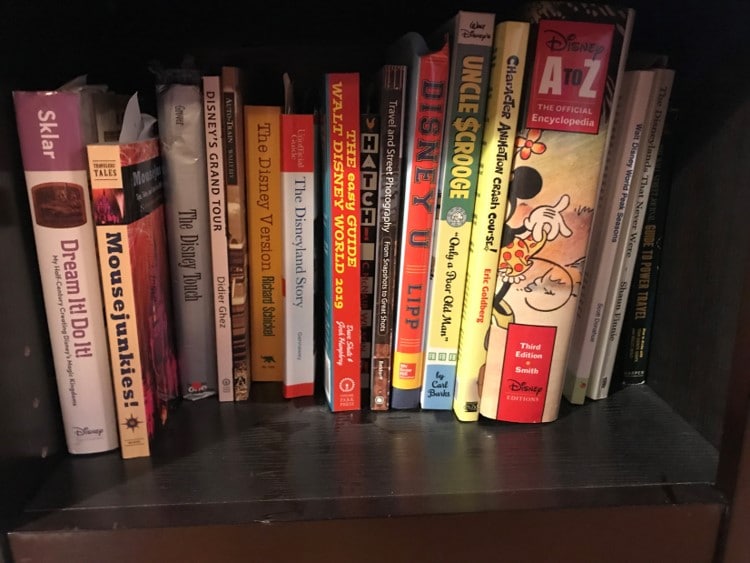Category — A Friday Visit with Jim Korkis
A Friday Visit with Jim Korkis: Disney A to Z
Welcome back to Fridays with Jim Korkis! Jim, the dean of Disney historians, writes about Walt Disney World history every Friday on yourfirstvisit.net.
YOUR PERSONAL DISNEY LIBRARY (10)
By Jim Korkis
- Disney A-Z: The Official Encyclopedia (2016) by Dave Smith
I can’t believe you don’t already have a copy of this valuable reference in your library, but you may perhaps be dragging your feet to purchase the latest edition that is 864 pages long with over 7,000 entries. Editions came out in 1996, 1998, 2006, 2015 (exclusive limited Sam’s Warehouse club edition), and 2016.
I’ve known the author of Disney A to Z, Disney Chief Archivist Emeritus David R. Smith, for decades. I did a lengthy interview with him on March 16, 2005 at Walt Disney World where among other things we talked about this book.
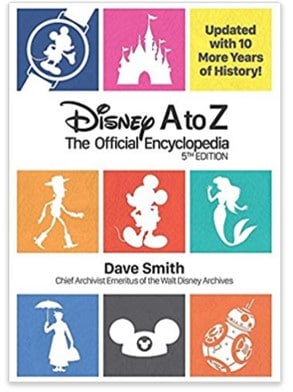
“What I did though in 1998, the minute that I shipped off the manuscript for the updated version to the publisher, I started putting onto my computer all of the new material that would then go into the next edition. You know what’s happening with the company all the time: we’ve got new movies coming out, we’ve got attractions opening at the park, we’ve got attractions closing at the park, we’ve got songs winning Oscars and all that sort of thing.
“All this type of information as it crosses my desk, I just type it into the computer right there! So, I’m up to date as of Friday and it’s Disney Editions now that publishes the Disney books. If they say we’re ready to do your new edition of Disney A to Z, the next morning I will ship off the computer disc and they’ll be all ready to go!
“Well, as you know, so many of the questions you get over and over again so you find that maybe 95% of the questions you can answer without doing any research whatsoever and then the other 5%, some of them take a lot of research to try to find the answers.
“That’s the reason I wrote Disney A-Z: The Official Encyclopedia so that I would have all that information at my fingertips rather than going through different file folders. Primarily, we utilized most frequently three huge file folders. One listed all the films and material about them. Another had a listing of all the theme park attractions and when they opened and closed. The third was a listing of people who had worked at Disney.
“We would keep getting requests that somebody’s great aunt had said they worked at the studio and they wanted to know when or just to check. Things happen quickly at Disney and without warning and one of the challenges I have being based in California is getting accurate opening and closing dates for things at Walt Disney World. Fortunately, cast members have been a huge help in that area.
“There was no money to pay for photos, so I took my own camera out and took pictures for that first edition because since I was on salary, they didn’t have to pay me anything additional.”
The WDW material is not as complete as the Disneyland material, but it is still valuable and authoritative. Even with the publication of this latest volume, Dave continues to constantly update and add entries online here.
* * * * *
Thanks, Jim! You can see my copy of one of the older editions here:
And come back next Friday for more from Jim Korkis!
In the meantime, check out his books, including his latest, More Secret Stories of Disneyland, and his Secret Stories of Walt Disney World: Things You Never You Never Knew, which reprints much material first written for this site, all published by Theme Park Press.
Follow yourfirstvisit.net on Facebook or Twitter or Pinterest!!
September 21, 2018 No Comments
A Friday Visit with Jim Korkis: A Field Guide to Pandora
Welcome back to Fridays with Jim Korkis! Jim, the dean of Disney historians, writes about Walt Disney World history every Friday on yourfirstvisit.net.
PANDORA IN DISNEY’S ANIMAL KINGDOM
By Jim Korkis
In the 2009 film Avatar, filmmaker James Cameron envisioned a moon called Pandora in the Alpha Centauri system orbiting the gas giant Polyphemus, with an atmosphere on the moon unbreathable for humans without assistance from Exo-packs.
Earth personnel in the presence of the Resources Development Administration, a quasi-governmental company, travel to this distant place in the 22nd century primarily to mine a rare mineral whose superconductive properties allow it to float in magnetic fields.
In addition, scientists studying the indigenous humanoid species called the Na’vi and the unusual fauna and flora also accompany the private security contractors employed by RDA.
Cameron meant to draw parallels between the lush, tropical forests of this science-fiction inspired moon and the supposed devastation of the ecology on the current Earth where humans have turned their planet into a global urban slum where little remains of a functioning natural ecosystem. He also wanted to make connections between the Na’vi’s spiritual relationship and responsibility to their world which have allowed it to flourish.
Cameron utilized a team of expert advisors in order to make the various examples of fauna and flora as scientifically feasible as possible. The Pandoran ecology is inter-connected from the floating mountain ranges to winged banshee predators.
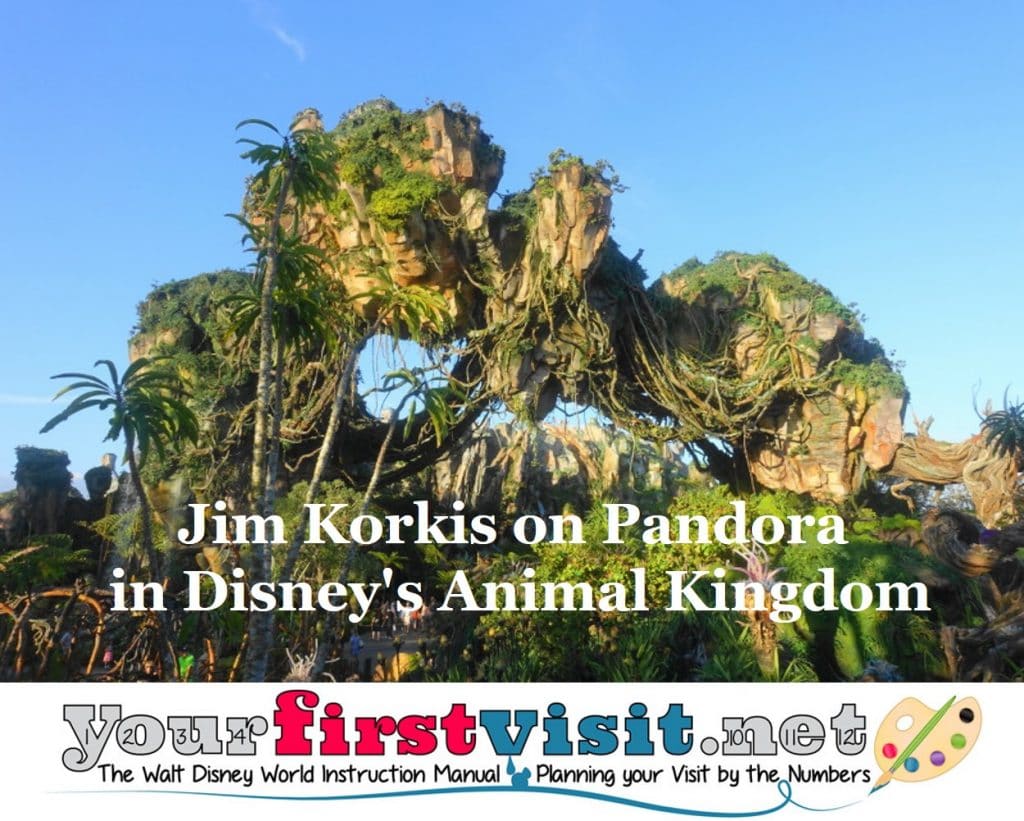
The Na’vi people, according to Disney, “possess humanlike consciousness and intelligence. The average Na’vi is three meters tall with cyan-colored skin and bioluminescent markings. They have large almond-shaped eyes, long torsos and a prehensile tail.”
Throughout the area are examples of Pandoran plants and Disney published a flyer explaining what they are when the area first opened.
“The diversity of Pandoran plant life and its range of size and complexity suggest that the environment of Pandora acts as a strong force for natural selection. The environmental factors that plants experience on Earth – radiation, water, atmospheric gases and gravity – are present on Pandora, although their characteristics differ profoundly.
- “Spiny Whip: The cup-shaped top of this plant collects raindrops and many species of birds use the plant as a source of water.
- “Panopyra: This plant captures water and minerals from dew and fog. The Na’vi collect the liquid and use it as a healing drink.
- “Vein Pod: The pods produced by these trees help to detoxify the atmosphere on Pandora, maintaining stability in the environment.
- “Flaska Reclinata: This plant absorbs, condenses and purifies atmospheric toxins on Pandora.
- “Dapophet: The leaves at the top of this plant have healing properties used by the Na’vi, while the leaves along the stem store water and are used as portable hydration.
- “Puffball Tree: This tree is an important plant on Pandora for purifying the atmosphere. The Na’vi also harvest its leaves for salt.
- “Grinch Tree: This tree grows in a hunched shape with a twisted trunk and bluish bioluminescent leaves.”
Producer and director James Cameron stated, “I think I knew (the theme park version) was going to be a pretty amazing world but I was still thinking ‘movie’. You can walk around and smell the world, touch the world. I wander around with a sense of wonder myself. I had an amazing time working with the Imagineering artists as they conjured all of this.
“This has been a transformative adventure for me. It’s certainly transformed my perception of what is possible in the real world. If you had asked me ahead of time, I would have said this is not possible. What they have created here is not possible.”
* * * * *
Thanks, Jim! And for more on the transformation of Disney’s Animal Kingdom, see this.
And come back next Friday for more from Jim Korkis!
In the meantime, check out his books, including his latest, More Secret Stories of Disneyland, and his Secret Stories of Walt Disney World: Things You Never You Never Knew, which reprints much material first written for this site, all published by Theme Park Press.
Follow yourfirstvisit.net on Facebook or Twitter or Pinterest!!
September 14, 2018 No Comments
A Friday Visit with Jim Korkis: Duffy the Bear
Welcome back to Fridays with Jim Korkis! Jim, the dean of Disney historians, writes about Walt Disney World history every Friday on yourfirstvisit.net.
DUFFY THE BEAR
By Jim Korkis
A new best friend for Duffy the Bear, Cookie, had her global debut July 2018 at Hong Kong Disneyland. The Disney Company has been attempting to capitalize on the Duffy craze by introducing new characters, starting in 2016 with Shellie May and Gelatoni. Stella Lou joined in 2017 and this year a yellow female dog who is a “foodie” named Cookie has joined the squad.
Olu, a turtle, made his debut at the Aulani resort on July 27. As Mickey Mouse and Duffy were sailing the islands looking for a perfect birthday present for Shellie May, they heard the sounds of a ‘ukulele calling them over to a cove where a kindhearted turtle named ‘Olu played happy tunes. They decided he would be a perfect present to sing “a special song of friendship and love.”
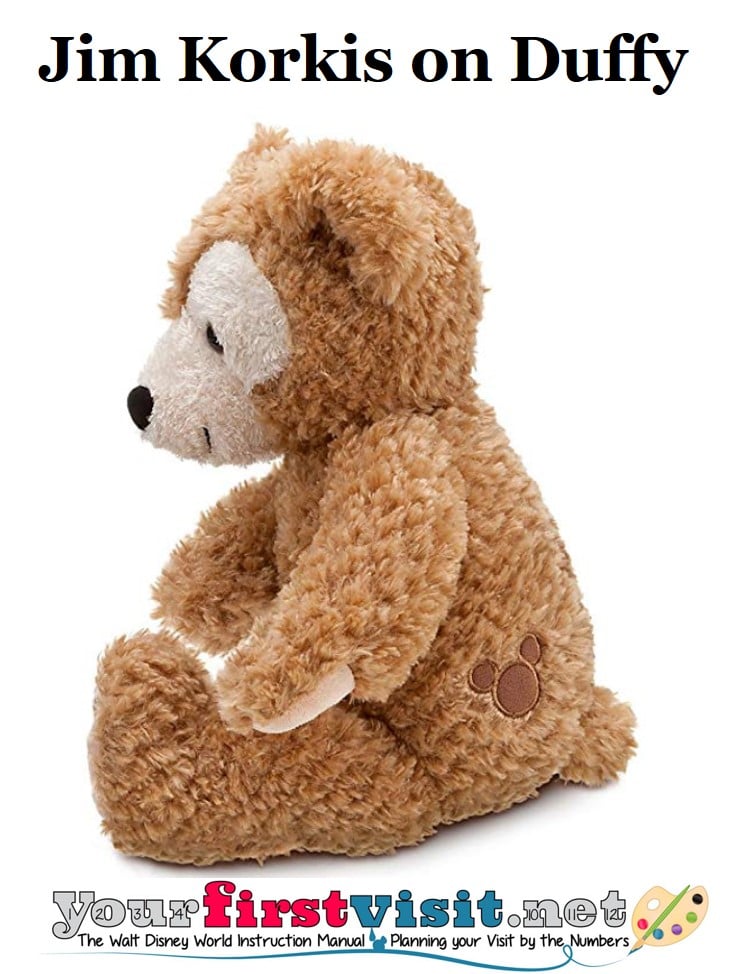
Dubbed the “Disney Bear”, it was risky because the introduction of the character would not be supported by any previous appearances in animation, comics, records or any other media. Basically, there was the hope that people’s love for teddy bears, and especially one with four “Hidden Mickeys” who was meant to be Mickey’s friend, would be enough to generate sales. He was only available at Walt Disney World.
Yet, despite all efforts to re-theme the bear, the product was considered a “dud” by the Disney Company, who cleared their shelves and sent the remaining stock to their outlet stores.
The Disney Bear was indeed cute, and the Japanese have always had an affection for things that have cuteness. The product was introduced to Tokyo DisneySea Resort as a special limited promotion for the Harborside Christmas celebration in 2004 in the American Waterfront area. It was still called the Disney Bear.
In December 2005, the bear was re-named Duffy because he was carried in Mickey’s duffel bag and marketed not just as a product to sell, but an experience to share. The character definitely fit in with the themes of Tokyo DisneySea including water exploration and adventure which is one of the reasons for Duffy’s sailor suit.
Duffy became established as a “photo and fashion” character. In Japan, costumes for Duffy expanded at a frightening rate including many limited editions.
Of course, the Disney Company saw that guests were buying multiple Duffys to carry around as well as all the costumes, so they decided to re-introduce the character in the Disney parks.
The official relaunch was October 14, 2010, at Epcot at Walt Disney World because Duffy was a world explorer, although he was also re-introduced that same day at Disney California Adventure in California.
Officially, the Disney Company maintains that Duffy is not a revised version of the “failed” Disney Bear. Rather, Duffy is a “cousin” of the Disney Bear.
In January 22, 2010, the Oriental Land Company—the owner of Tokyo DisneySea–introduced a “friend” for Duffy, a little girl bear in a soft shade of pink named Shellie May. Actually, at one point, they considered the girlfriend would be a pink cat with polka dots (to theme in with Minnie Mouse) and dark red Mickey head silhouette imprint on her behind. Some prototypes were made.
Duffy brings happiness and Shellie May’s slogan is that she brings joy. She especially brings joy to the financial bottom line because the Oriental Land Company launched sets of matching costumes for Duffy and Shellie May, including new matching set costumes for every season. There seems to be no limit to the number of costumes. Nor any limit to the number of new friends for the pair that interconnect with other available merchandise.
The marketing phrase for Duffy is “Where will you take Duffy next?” For the Disney Company the answer is “to the bank….every day.”
* * * * *
Thanks, Jim! And come back next Friday for more from Jim Korkis!
In the meantime, check out his books, including his latest, More Secret Stories of Disneyland, and his Secret Stories of Walt Disney World: Things You Never You Never Knew, which reprints much material first written for this site, all published by Theme Park Press.
Follow yourfirstvisit.net on Facebook or Twitter or Pinterest!!
September 7, 2018 No Comments
A Friday Visit with Jim Korkis: The Art of Walt Disney World
Welcome back to Fridays with Jim Korkis! Jim, the dean of Disney historians, writes about Walt Disney World history every Friday on yourfirstvisit.net.
YOUR PERSONAL DISNEY LIBRARY (9)
By Jim Korkis
- The Art of Disneyland (2006) and
- The Art of Walt Disney World (2009),
both by Jeff Kurtti and Bruce Gordon
It is a sad fact of life that some of the best books about Walt Disney World go out of print quickly and become difficult to find and highly expensive once they are found. However, I look at this column as an opportunity to alert you not only to books you can immediately purchase but also a handful of those that you may want to put on your wish list.
I have found that with patience and persistence you can sometimes find one of these treasures at a reasonable price and still in good condition [see the links–Dave].
The Art of Disneyland by Jeff Kurtti and Bruce Gordon came out September 2006 from Disney Editions and was originally meant to commemorate the fiftieth anniversary of Disneyland. It was a huge book at 10.5 x 0.6 x 13.4 inches and weighing roughly two and a half pounds. It had to be turned sideways in order to see the artwork.
It was originally exclusively available at the theme parks and was 129 pages long. It had magnificently large pieces of color concept art including everything from John Hench’s 1954 design of the proposed Space Port in Tomorrowland to Marc Davis’ 1961 watercolor of the bathing elephants addition to the Jungle Cruise. In the back are four pages of short biographies and color photos of some of the Imagineers.
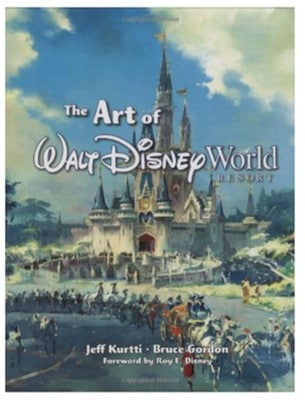
The artwork ranges from Mary Blair’s 1970 collage and acrylic for the new finale scene for WDW’s it’s a small world attraction to Herb Ryman’s 1980 acrylic piece showing the proposed Equatorial Africa Pavilion for Epcot to Paul Hartley’s famous 1971 “Fun Map” that once adorned the resorts when Walt Disney World opened in a clear, crisp reproduction.
The official description of the book is: “A showcase of the varied art and artists of Walt Disney Imagineering, The Art of Walt Disney World is a stunning collection highlighting the rich and vivid creative inspiration behind the development of the landmarks, attractions, architecture and shows that constitute this popular Vacation Kingdom.
“Selected from hundreds of thousands of conceptual materials, sketches, layout drawings and paintings in the collection of the Walt Disney Imagineering Library, this illustrated celebration of Walt Disney World features meticulously reproduced art with lavish production values in a beautiful large-format book that is destined to become a spectacular keepsake for fans of the resort, as well as art collectors and Disney fans everywhere.
“In addition, each illustration is presented with erudite and fascinating information about the projects, ideas, context and people involved in the creation of Walt Disney World that will further enrich the reader’s appreciation of the exceptional talent behind Walt Disney World’s creation – and perpetual evolution. With a personal introduction by Roy Edward Disney, The Art of Walt Disney World contains countless wonders to captivate, inform and entertain.”
I certainly can’t offer a better description than that one other than the fact that Jeff Kurtti and (the late) Bruce Gordon are two of my favorite Disney historians known for their accuracy, extensive original research and their wide range of knowledge.
So, in addition to artwork I personally had never ever seen before, there are a couple sentences of text for each piece to help better understand what is being shown. I am a huge fan of how things were created and developed and this book just whets my appetite for more.
If you are a fan of Walt Disney World and its history, this is a wonderful and out-of-the-ordinary book to include in your collection. It would be nice if Disney Editions considered updating and reprinting both editions. Until that time, happy hunting for this out-of-print treasure!
* * * * *
Thanks, Jim! And come back next Friday for more from Jim Korkis!
In the meantime, check out his books, including his latest, More Secret Stories of Disneyland, and his Secret Stories of Walt Disney World: Things You Never You Never Knew, which reprints much material first written for this site, all published by Theme Park Press.
Follow yourfirstvisit.net on Facebook or Twitter or Pinterest!!
August 31, 2018 No Comments
A Friday Visit with Jim Korkis: Star Wars: Galaxy’s Edge
Welcome back to Fridays with Jim Korkis! Jim, the dean of Disney historians, writes about Walt Disney World history every Friday on yourfirstvisit.net.
STAR WARS: GALAXY’S EDGE
By Jim Korkis
Anticipation for the newest addition to Disney’s Hollywood Studios, Star Wars: Galaxy’s Edge, continues to build at an alarming rate, since its opening is roughly only a year away.
WDI Story Editor Margaret Kerrison shared the name of the village on Batuu that will be the setting of the land: Black Spire Outpost. The planet Batuu has not previously appeared in other Star Wars media. The story is that it was once a busy crossroads along the old sub-lightspeed trade routes, but its prominence was bypassed by the rise of hyperspace travel. It also has become a convenient safe haven for those intent on avoiding the expanding reach of the First Order.
Black Spire Outpost is “the largest settlement on the planet and is known as being a hive of scum and villainy, where traders, adventurers, and smugglers traveling around the Outer Rim and Wild Space can stay off the beaten path; this outpost has become a haven for the galaxy’s most colorful — and notorious — characters. Famous for its once-gigantic prehistoric petrified trees, the spires now tower over the landscape. To the first settlers, these looming spires became more than just landmarks; they became the fortress of the outpost itself.”
This new location that is the largest single land expansion in Disney theme parks history is the result of cooperation between LucasFilm, Walt Disney Imagineering, and Disney Parks.
Imagineer Scott Trowbridge says that the same teams who provide makeup, special effects, and costumes to the saga movies at Pinewood studios also contributed to creating material that will bring Star Wars: Galaxy’s Edge to life.
The team had to take things more than a step further than the movies by actually building elements in the real world that guests will actually experience rather than digital recreations. In other words, actual-sized AT-ATs and X-Wing fighters are under construction.
One of the attractions guests will get to board and fly is the Millennium Falcon on a customized secret mission. The other new attraction involves an entirely new, life-sized Resistance troop transport ship that guests will climb aboard and feel like they’re inside a hangar bay in the middle of a battle between the First Order and the Resistance. There will also be a cantina serving blue milk with Rex, the troublesome pilot from the original version of Star Tours, as the DJ at the cantina.
In addition, there will be a toy stall overseen by a Toydarian, a creature first seen on Tatooine in Star Wars: The Phantom Menace. Eric Baker, the creative director of Disney Imagineering, is overseeing the creation of a “creature stall” as well, which is essentially a petting zoo full of aliens.
“Everyone loves the creatures of Star Wars, be they cute or cuddly or creepy and scary – you’ll get to see them all in this place,” Baker said. “The creatures will come to life, and you’ll get to take one home with you if you’re lucky.”
The team has sought out the same sources of props as those used in the films. It has also taken the additional step of working to bring many of the creatures to life, such as a loth-cat that appears in the Star Wars Rebels animated series.
Due to the popularity among fans of the supporting character Nien Nunb from Return of the Jedi who co-pilots the Millennium Falcon alongside Lando Calrissian, he will appear and interact with guests. The WDI team searched for the original voice actor, Kipsang Rotich. He was a Kenyan student studying in the San Francisco area at the time that film was made and had returned to Kenya after the completion of his studies.
He later also voiced the character in The Force Awakens and The Last Jedi. The character of Nien Nunb was portrayed both by a puppet and costumed actor. The character was an arms dealer of the Sullustan species who joined the Alliance to Restore the Republic during the Galactic Civil War. He became a starfighter pilot in the Resistance who fought during the Battle of Starkiller Base. Other characters including Harkos the bounty hunter will also appear in the new land.
* * * * *
Thanks, Jim! I have some forecasts for Galaxy’s Edge here. And come back next Friday for more from Jim Korkis!
In the meantime, check out his books, including his latest, More Secret Stories of Disneyland, and his Secret Stories of Walt Disney World: Things You Never You Never Knew, which reprints much material first written for this site, all published by Theme Park Press.
Follow yourfirstvisit.net on Facebook or Twitter or Pinterest!!
August 24, 2018 1 Comment
A Friday Visit with Jim Korkis: Hidden Mickeys
Welcome back to Fridays with Jim Korkis! Jim, the dean of Disney historians, writes about Walt Disney World history every Friday on yourfirstvisit.net.
HIDDEN MICKEYS
By Jim Korkis
A Hidden Mickey is an image of Mickey Mouse found unexpectedly in a theme park, resort, cruise ship or other Disney location.
It is most commonly the tri-circled silhouette of Mickey’s head that might be found in a swirl on a piece of furniture, or an arrangement of rocks and plants, or a carpet pattern or some other grouping in a context that might not normally contain Mickey.
However, some of these designs are intentional and are considered “Decorative Mickeys” because, after all, Mickey is the icon of the Disney Company and is utilized throughout these same locations.

Like many Hidden Mickeys, with the closure of the Great Movie Ride, that one no longer exists, which is why the parks do not publish an “official” list–because it is constantly changing.
Walt Disney World is home to the rarest Hidden Mickey of them all. In the Under the Sea: Journey of the Little Mermaid attraction at the Magic Kingdom, the rarest Hidden Mickey can only be seen on November 18, Mickey’s birthday, at noon if the sun is shining.
Imagineers drilled three holes in the ceiling that on that day and time will create the famous three-circle Mickey image on the wall on the queue line at about knee-level. It has appeared for just a few minutes every year since the attraction was first opened in 2012.
There have always been unofficial Hidden Mickeys. One of the first was in the 1955 Disneyland Rocket to the Moon attraction where the rapidly diminishing spaceport (designed by Imagineer John Hench) in the bottom viewport had a remarkable resemblance to Mickey’s head including the proper proportion and vector of the ears to Mickey’s main circle.
However, the current unofficial “Hidden Mickeys” originated at Epcot in 1982. The secret was revealed to the general public in the December 1991 issue of Disney News magazine in an article by Imagineer David Fisher:
“When EPCOT Center opened at Walt Disney World in 1982, a conscious decision was made to give the new Theme Park a distinctly separate identity from the older, more familiar Magic Kingdom. One of the ways this was done was to purposely keep all references to the Disney characters out of the new Park.
“Leave it to the devious denizens of Walt Disney Imagineering to work the familiar ears or silhouette into just about anything they could during those early, no-Mouse days of EPCOT Center.”
Once Michael Eisner became CEO, he put an end to the moratorium of Disney characters at Epcot because he knew guests wanted the characters there.
Actually, Disney cast members had been alerted to Hidden Mickeys two years earlier in a magazine article by Disney cast members Arlen Miller and Bob Weir in their “Hidden Disney” article for the November 30, 1989 edition of the cast member newspaper Eyes and Ears (Vol. 19, No 48).
Today, there is a very popular series of books beginning in 2002 and constantly updated by Steven M. Barrett (who also maintains a website HiddenMickeyGuy.com) to help fans locate some of these Hidden Mickeys since they are constantly being added and removed.
Some Imagineers prefer not to encourage the guests’ fascination with the phenomenon because they feel it distracts the guests from being immersed in the entire experience. They have even less patience with cast members who deliberately create Hidden Mickeys since they consider it as solely an Imagineering prerogative.
* * * * *
Thanks, Jim! And come back next Friday for more from Jim Korkis!
In the meantime, check out his books, including his latest, More Secret Stories of Disneyland, and his Secret Stories of Walt Disney World: Things You Never You Never Knew, which reprints much material first written for this site, all published by Theme Park Press.
Follow yourfirstvisit.net on Facebook or Twitter or Pinterest!!
August 17, 2018 2 Comments

